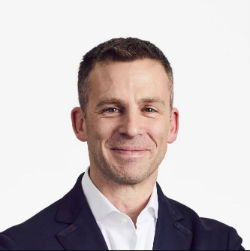
“Great question. I would deliberately call it a brand refresh, which was to look at who we were and what we do really well, as well as some of the opportunity areas. We spent time speaking with our customers to see what they think of us versus what we think about ourselves internally. Then as you go through the refresh process, you come out the other end and say: What do we want to keep and what needs to change or be augmented potentially?

“Candidly, the Epicor brand is a strong brand. It had a lot of meaning in the marketplace. It just didn’t necessarily match some of the perceptions of people who work with us every day. They were saying, Hey, you guys are way further ahead than people understand, even as we understood as customers.
“If you went to our website, about six months ago, it looked a little bit out of date, a little bit stodgy. It was hard to understand what exactly it is we do and don’t do. That was the impetus of the brand refresh. It was a case of customers saying, maybe you’re being misunderstood. That’s a good time to take a long hard look at yourself.”
What exactly did you change for the Epicor brand?
“A lot of it is under the covers, brand architecture, the taxonomy and simplifying the naming of our different products and platforms that serve our five core industries. We really are about the people who make, sell and deliver.
“How do you take what was roughly 72 products and streamline that into a way that people can easily comprehend and understand? What do you do and who do you do it for? Ultimately you go through a lot of what you had to bring to market, and does this match that? There’s been a lot of simplification. Rewriting things so that it is comprehensible by the people we serve. I’m not trying to be all things to all people, but again, be really specific to the ones we do work with.”
So more focused effectively?
“Absolutely, that’s the key. Out of the whole thing, what is clear is our promise as an organisation: “We make with you and we make for you”. We work hand in hand with customers every single day, from how we think about the roadmap with the customer advisory boards through to delivering for our customers. Those sorts of things come through really strong. It’s about leaning into that promise and anything that distracts away from it has a hard conversation at the chopping block.”
On the logo
You updated the Epicor logo as part of the refresh, is there a meaning behind the change?
“The name was something that was profound and meant something to the people who interact with us, our customers. There was less of a need and definitely not a desire to change the name both internally and externally. We wanted to lean into the heritage but look forward to the future.
“There are elements of refreshing it, making it sharper, make it feel more connected to who we are today. It’s a little bit rounder. You’ll notice there’s a lowercase e at the front, which still, has a bit of a retro look to it, but it’s got a little bit more futuristic feel. It’s pulling on both sides, future and past, but very, very clearly who we are still.”
A quiet rebranding
Why the soft change? There wasn’t a major announcement, it just sort of happened.
“That’s a good marketers question. The reality is, I might be accountable for the brand, but the people who are responsible for delivering it are all through the organisation from the CEO to the people who do our services and support. For us, it was a case of making sure that we’re delivering to that promise in delivering the brand experience. To make sure it’s getting applied with our customers into the market versus just going out and screaming, shouting and telling people, ‘Hey, I’m here, and I’m really nice’.
“Just because you say it, doesn’t mean you are. It was more important for us to get the how, really baked, as well as the what. That’s why the softer approach, internally focused externally felt, For me, it’s more of a genuine way of delivering brand.”
What about all the acquisitions?
Did you consider creating brands for some of those different industries because some of your products are very different. For example, the automotive aftermarket is a very different product than the traditional Epicor ERP (now Kinetic).
“It’s a consideration candidly as you go through the brand work. You look at every part of your business. You could look at these five separate parts of the business but that isn’t how I look at it. Brand strategy should follow business strategy. We don’t look at those industries as five completely separate businesses. We look at it all as Epicor.
“The reality of Epicor is our promise of making it with you, for you, remains the same across those industries. Adding new brands or going to market as separate entities, doesn’t simplify it. It doesn’t add to the businesses and it certainly doesn’t add to the customer. It’s more about leaning in and explaining what we do and why we’re doing it. It was a consideration, but in this case, wasn’t the desired or the right route.”
Has it made a difference to the Epicor brand?
How are you measuring the impact of the change?
“Multiple different ways. Long term wise, your brand is meant to be the perceived valuation of an organisation. There’s a whole set of metrics but it’s a bit early to tell where we’ll stand from that perspective. Midwise we tend to look at things like, are we seeing the better growth of understanding of our business? Is the brand supporting that? The reality is that people understand us better, it’s a more simplified experience. There’s a belief that will translate into, your core business results.
“Short term, the web is a great proxy of people’s understanding, and your awareness and market. We’re looking at things like our chat platform. What sort of questions are we getting? Are there as many questions as they used to be around, what do you do? And where do I find it? Are we making a better experience for our customers? Brand is about a long term relationship. You want it to be as good a relationship as you can.”
Is there a quantifiable impact from the brand refresh?
“Being able to articulate what we do, and who we do it for, has an impact both internally and externally. Internally wise, definitely more galvanised. We all know we’re working on something that we genuinely believe in. We heard this time and time again, that we’re the essential partner to the world’s most essential businesses over the course of the last year. That was a pretty, humbling thing to hear. A lot of the heavy lifting was being done by the HR Team around one Epicor and making sure that we weren’t a siloed organisation. Going through the brand work has solidified that.
“Externally we’re seeing quantifiable results from traffic increase. The measures that we’re looking at in the short term is to drive a simplified, rationalised and better experience with customers, where we’re engaging with them in a more meaningful way. Even, in the short time that we’ve been under the refreshed brand experience, we’ve seen increases across the board.”
What is next?
Having done the brand refresh what is next on your to do list?
“A big part of our work moving forward is making sure that we are creating a different level of content. A more engaging, more simplified, set of content to the right audiences at the right time.
“Marketing these days is about what I would call BtoI versus B2B or B2C. It’s about business to the individual, making sure they have the right content or the right information they need when they need it. That creates a completely different architecture from your marketing platform that you use, through to what sort of content you create.
“For me, as a marketeer, it’s about a lot of optimization of the tools we use. And, a lot of creative discipline around making sure that we do deliver content, to our brand.”
When you say B to I do you mean business to role?
“That’s another great way to describe it.”
On the future?
What do you hope to achieve by the end of 2021?
“It’s probably shifted because honestly, this has just been such a year of change for everyone. Last year we had to pivot internally a lot, learn a lot of new skills, use technologies, capabilities that weren’t there before. We were heavily focused on in-person events, and that shifted to virtual, and then people got fatigued by the end of the year. Having a really, really settled way of being able to market without it all feeling completely new every single day would be a great achievement.
“From a metrics perspective, we want to keep solidifying the brand. Make sure that we drive that consistency of message into the market and replay back to our customers what they told us more eloquently than maybe we’re telling ourselves. There’s a lot of work there to do from delivering to that side.”
On Challenges
What are your main challenges at the moment?
“Marketing wise, it is probably building a world-class discipline in an environment where marketers are just red hot. Everybody is looking for the best marketeers. I’ve always had the belief that A players hire A players and the A players out there are just red hot in the marketplace. If you believe in constantly raising the bar, then that’s a constant challenge. As a marketeer. It’s talent, having the right talent, attracting, keeping, and training, that’s absolutely number one.
“For the business, it’s actually probably the same candidly. When Steve Murphy took over the organisation, he absolutely wanted to raise the bar on the disciplines across the organisation, whether that be, sales organisation, through to Himanshu leading the development of our products. It was a step-change, approach. That’s his expectation of me for marketing as well. we have made a step-change. We’ve had to do an awful lot of change internally to raise the bar. It’s about constant improvement. Don’t think what you’ve done is good enough, keep striving for what’s next, and how to be better.”
The book question
What’s the latest business book you read?
“It was Essentialism (Essentialism: The Disciplined Pursuit of Less by Greg McKeown – Amazon Aus, UK, US) and it’s not a new book. I’ve read it a few times, done the webinars around it. In this day and age, focusing on the things which are really going to move the dials and things which are most important, not just for business, but for yourself, it’s a good reminder. Great book.”


























